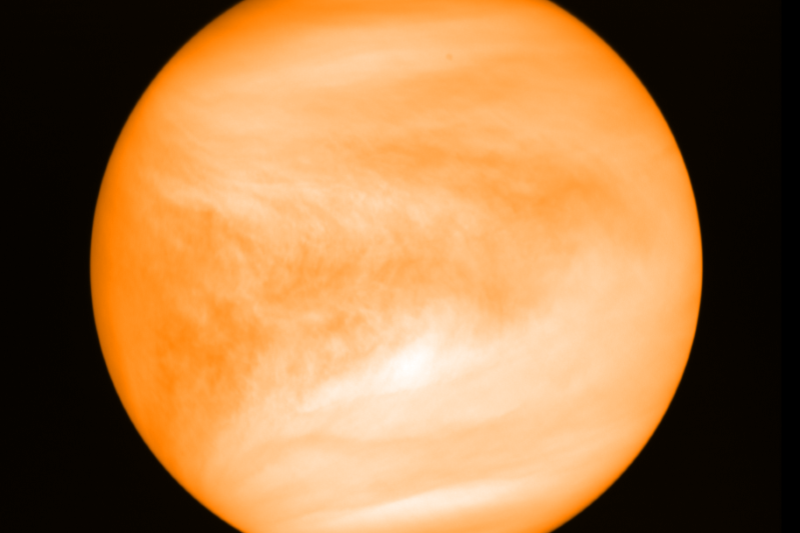Aliens over Venus? Astronomers catch a whiff of life in planet’s clouds


Can you smell what the rocky planet of Venus is cooking? Because it might be the alien life we've been trying so hard to find
Astronomers say they've detected a chemical in the Venusian clouds that likely can only be produced by organic life, in a stunning discovery that shines a new spotlight on Earth's other planetary neighbour.
Venus is named for the Roman goddess of love and beauty, but its conditions are not for the faint of heart. With its blistering-hot temperatures, rocky surface and poisonous clouds, the planet has long been dismissed as a potential host for life. Instead, scientists have spent decades searching for microscopic aliens on Mars and distant moons such as Titan and Europa. However, two telescopes recently detected the presence of phosphine in the clouds over Venus, according to a study published Monday in Nature and another submitted to the journal Astrobiology. The chemical only comes from factories and microbes living in oxygen-free environments on Earth, and there is no other known natural process for producing it.
That means there's no way the chemical should exist in this form except "from the presence of life" or through some bit of never-before-seen chemistry, according to the study authors.
Either way, Venus is suddenly ththe hottest place to look for aliens in our solar system (sorry Mars). "I was just stunned," said Jane Greaves, the lead study author and a professor at Cardiff University in the United Kingdom. The discovery is not proof of life, but it's a good lead that will help astronomers narrow the scope on what sort of aliens they should be looking for on Venus, according to Greaves.
“We’re talking, if they’re there, I think probably single-celled organisms, but they’d probably be pretty different to something on Earth,” she told Reuters. She adds that microbes would likely need to develop shells to survive in the intense sulphuric acid clouds over Venus. "They might not be something we'd recognize very easily," she said. It is the hottest place to look for aliens in our solar system (sorry Mars).. In other words, potential aliens on Venus would look pretty weird to us.
Greaves and an international team of researchers made the discovery while scanning Venus with telescopes based in Hawaii and Chile. The telescopes scan at a wavelength that humans can't see, and Greaves pointed them at Venus in hopes of ruling out some crazy possibilities. "I thought we'd just be able to rule out extreme scenarios, like the clouds being stuffed full of organisms," she said, in a statement released by the U.K.'s Royal Astronomical Society. "When we got the first hints of phosphine in Venus' spectrum, it was a shock!"
Phosphine is highly toxic to humans and rare in nature, except in oxygen-starved environments like sewers and ancient, sealed-off caverns . Microscopic organisms can produce it by combining phosphorus with hydrogen. Greaves and her team investigated a wide range of other possible phosphine sources — such as volcanoes and lightning — but found they don't make sense for the amount detected over Venus. "Phosphine is a phosphorous atom and three hydrogen atoms and there's really very little hydrogen available in the atmosphere so we think something is ... making it, and one of the possibilities is it's small, floating organisms," Greaves said.
Venus is an extremely hostile environment. The planet is slightly smaller than Earth, closer to the sun and shrouded in carbon dioxide and sulphuric-acid clouds that create a supercharged greenhouse effect. The surface of Venus is a searing 465 C, which is hot enough to melt lead. The planet's toxic clouds are a relatively comfortable 30 C, and astronomers have wondered for years if something might be able to survive in the atmosphere. They've also been curious about a patch of phosphorous among the clouds that may have been used to make the newly discovered phosphine. There are only small amounts of phosphine in Venus' atmosphere, but still, enough that it could only have been produced by an organism, the study authors say.
However, more investigation must be done to confirm the presence of life, rather than to simply infer it, critics say. “This can hardly be taken as a biosignature,” biologist Gerald Joyce told the New York Times . Sarah Stewart Johnson, a planetary scientist at Georgetown University, says it’s a thrilling step in the search for life, even if it's not definitive proof. “There’s been a lot of buzz about phosphine as a biosignature gas for exoplanets recently,” she told the Times. “How cool to find it on Venus.”
Johnson, who was not part of the study, says Venus has been ignored for too long. “It’s really a shame,” she said. The news may help scientists finally figure out if we're alone in the universe — or if we've got some sizzling-hot neighbours on Venus



While obviously more investigation is needed this is interesting research.
Maybe a return to Venus for some sort of atmospheric scoop mission is in order.
Indeed. It would be awesome if life actually did develop on Venus. That would open up new possibilities of where to look for or find life, not to mention expand our understanding of how different life can develop and maybe even evolve under certain conditions, including extreme environments.
Absolutely agree
Going from the article I got to pondering what form the described potential life would take, tiny little winged shelled creature soaring around on the thermals.
tiny little winged shelled creature soaring around on the thermals.
I'd say there is almost certainly life elsewhere in the universe, just from a mathematical probability standpoint alone. Finding it is only a matter of time. Or maybe it finding us? And yes, we have come a long way in hundreds or even thousands of years. Thanks to science that is. Imagine how far we'll advance hundreds or even thousands of years from now (assuming we don't go extinct in the meantime).
They would be bacterial extremophiles. How they would look under a microscope would be interesting.
I remember reading a novel, maybe twenty years ago, situated on a world like this. Nothing lived on the ground, but the atmosphere was full of life. Plants and animals floated, supported by gas-bags.
I have no memory of the plot.
supported by gas-bags
Hmm... There seems to be plenty of life here on Earth in the same situation.
Interesting. Thanks for posting the article